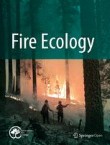Fire Ecology is the official journal of the Association for Fire Ecology.
Fire Effects on Basal Area, Tiller Production, and Mortality of the C4 Bunchgrass, Purple Threeawn
Fire behavior associated with wild and prescribed fires is variable, but plays a vital role in how a plant responds to fire. Understanding the relationship between fire behavior and rangeland plant community r...
